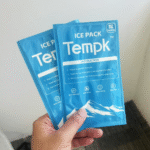Dry Ice Pack Food Delivery: How to Ensure Safe and Efficient Transport
When it comes to ensuring food arrives fresh and safe, especially for perishable items, dry ice packs have become a popular solution for cold chain logistics. This article dives into how dry ice packs work for food delivery and the best practices to ensure a smooth process. Whether you’re in food delivery or simply curious about the logistics, this guide is for you.
What Are Dry Ice Packs, and How Do They Help in Food Delivery?
Dry ice packs are solid carbon dioxide (Co₂) that sublimate directly from a solid to a gas at a temperature of -109.3°F (-78.5°C). Im Gegensatz zu traditionellem Eis, Trockeneis schmilzt nicht in Wasser, making it ideal for food delivery, where moisture can be harmful to some products. Dry ice packs maintain extremely low temperatures, making them suitable for keeping food frozen for extended periods.
They are commonly used in transporting frozen or temperature-sensitive foods, wie Fleisch, Meeresfrüchte, Eiscreme, und pharmazeutische Produkte. These packs not only prevent spoilage but also reduce the risk of bacterial growth by maintaining a low temperature throughout the delivery process.
How Do Dry Ice Packs Work for Food Delivery?
Dry ice packs function by maintaining a consistent low temperature throughout transit. They work by absorbing heat as they sublimate from a solid to a gas, which helps maintain the required temperature for food preservation. In the food delivery industry, this feature is especially important when shipping perishable goods over long distances.
Bei Verwendung von Trockeneis, it’s essential to consider the amount of dry ice required based on the duration of the delivery and the specific temperature needs of the food. The right quantity ensures that the food remains frozen and safe until it reaches its destination.
What Are the Best Practices for Using Dry Ice in Food Delivery?
Effective use of dry ice in food delivery requires careful planning and attention to several factors, such as safety and proper packaging. Below are some essential best practices for using dry ice in food delivery:
1. Proper Packaging for Dry Ice
Using the correct packaging is crucial to ensure safety and efficiency in the delivery process. Food should be sealed in insulated boxes or containers to prevent heat from reaching the food. The packaging should be durable enough to handle the extreme cold temperatures that dry ice produces.
Zusätzlich, it’s important to have Entlüftungsverpackung. Trockeneis unterschwellt zu Kohlendioxidgas, and if the gas cannot escape, pressure can build up, causing the container to explode.
2. Correct Storage and Handling of Dry Ice
Bei der Behandlung von Trockeneis, always use insulated gloves to avoid frostbite, as the material is extremely cold. It should be stored in well-ventilated areas to allow gas to dissipate safely. Lagern Sie niemals Trockeneis in luftdichten Behältern, as the buildup of carbon dioxide gas could cause pressure to build, leading to dangerous situations.
3. Calculating the Right Amount of Dry Ice
The amount of dry ice required depends on the size of the shipment, the duration of transit, and the type of food being transported. A general rule of thumb is that 5 Zu 10 pounds of dry ice can keep the contents cool for one day in a properly insulated container. Jedoch, perishable goods like seafood may need more dry ice to remain frozen throughout the delivery process.
4. Timing the Delivery for Freshness
Since dry ice sublimates over time, it’s essential to time the delivery carefully to ensure that the food remains at the right temperature upon arrival. Delivery windows should be as short as possible, and tracking the condition of the shipment during transit can help optimize the process.
How Does Dry Ice Compare to Traditional Ice in Food Delivery?
Traditional ice is made from frozen water, and as it melts, it creates water, welches kann dilute the contents of the delivery package. Im Gegensatz, Trockeneis does not melt into water, making it ideal for shipping certain foods that should not come into contact with moisture. Dry ice is far superior when it comes to long-distance and international food shipping, as it maintains a constant temperature for longer periods.
| Besonderheit | Trockeneis | Traditionelles Eis |
|---|---|---|
| Temperatur | -78.5°C (-109.3° F) | 0°C (32° F) |
| Water Generation | NEIN | Ja |
| Beste Verwendung | Ferntransport | Shorter-term storage |
| Sicherheitsvorkehrungen | Requires ventilation, Handschuhe | Leicht zu handhaben |
Is Dry Ice Safe for Food Delivery?
Ja, dry ice is safe for food delivery when handled properly. Der main safety concern with dry ice is its sublimation into carbon dioxide gas, which can be hazardous in poorly ventilated areas. Richtige Verpackung, Belüftung, and careful handling can mitigate these risks.
How Do You Ensure Proper Temperature Control in Dry Ice Food Delivery?
Ensuring that the food remains at the correct temperature throughout transit requires proper preparation and understanding of how dry ice works. Here are some tips to ensure Temperaturregelung is maintained:
1. Use the Right Insulation
Insulated packaging plays a vital role in Temperaturretention during delivery. Materials like styrofoam or vacuum-insulated panels can help to reduce heat transfer and keep the contents colder for longer.
2. Monitor Shipment Temperature
Tracking the temperature of the shipment is crucial, especially for longer deliveries. Temperatursensoren that alert you to changes in the shipping environment can help you respond quickly if temperatures rise beyond safe limits.
3. Plan for Timely Delivery
By ensuring that shipments are delivered within the shortest possible timeframe, you can maximize the effectiveness of dry ice and reduce the amount needed to maintain the desired temperature.
What Are the Benefits of Dry Ice in Food Delivery?
The use of dry ice in food delivery comes with multiple benefits. Here are the key advantages:
-
Longer Storage Time: Dry ice can maintain extremely low temperatures for up to 24 Stunden oder mehr, Abhängig von der Größe der Sendung.
-
No Water Meltdown: Since dry ice sublimates into gas instead of water, it is ideal for moisture-sensitive foods.
-
Effective for Frozen Foods: Dry ice is essential for transporting frozen goods that need to stay at sub-zero temperatures.
-
Environmental Safety: Unlike some chemicals used in refrigeration, dry ice is not harmful to the environment, provided it is used in well-ventilated areas.
Reale Anwendung: Successful Food Deliveries with Dry Ice
Many food delivery services have found great success in using dry ice to transport temperature-sensitive items. Zum Beispiel, a national seafood distributor uses dry ice to keep fish and shellfish frozen during long-haul deliveries, ensuring that customers receive their orders in pristine condition. By investing in high-quality insulation and carefully calculating dry ice amounts, they ensure that every shipment arrives safely.
2025 Trends in Dry Ice Pack Food Delivery
Neueste Trends
-
Nachhaltigkeit: As the food delivery industry shifts towards sustainability, companies are looking for more eco-friendly ways to use dry ice, einschließlich Recycelbare Verpackung and reducing emissions during transport.
-
Intelligente Verpackungen: Die Integration von intelligente Verpackungen that monitors temperature in real-time is a growing trend, offering more precise control over food safety.
Markteinsichten
The cold chain logistics market is rapidly growing, with dry ice emerging as the preferred solution for shipping perishable goods. As e-commerce continues to rise, the need for reliable and safe food delivery solutions will only increase, driving the demand for dry ice.
Common Questions About Dry Ice Food Delivery
Q1: How much dry ice do I need for a 24-hour food delivery?
For a 24-hour delivery, Sie werden da brauchen 5-10 Pfund Trockeneis, Abhängig von der Größe des Pakets und der Isolationsqualität.
Q2: Can I ship perishable foods without dry ice?
Ja, but dry ice is the best way to ensure that frozen goods remain in a safe temperature range during transit.
Abschluss
Using dry ice for food delivery is a reliable and efficient way to ensure the freshness and safety of perishable items. By following best practices, calculating the correct amount of dry ice, and choosing the right packaging, you can significantly improve your food delivery operations. Be sure to stay updated with the latest trends and technologies to make the most out of your dry ice food deliveries.
Nächste Schritte
If you’re looking to improve your food delivery process or need help with selecting the right dry ice solutions for your business, contact our experts today to get personalized advice on your logistics needs.























